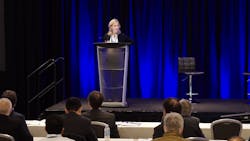Financial perspectives on the photonics industry
Linda Smith, President, Ceres Technology Advisors, started the first of two presentations with an investor’s view on the photonics business. She looked at the markets and their current behavior. In addition, she provided some insights on the valuation of photonics companies and recent merger and acquisition (M&A) activity (see figure).
From her perspective, photonics companies serve many vertical markets. In general, serving vertical markets means to provide several products or services along the value chain to some specialized customers. Such a tight relation between providers and customers in a small niche usually warrants higher profits. From biophotonics through defense to advanced manufacturing, this is mostly true for photonics companies.
But markets and business models are changing rapidly, as Smith showed in a number of examples. A radical transformation of consumer and end-user companies is currently happening through “a collision of industries.” When Amazon moves from being a book retailer to a provider of IT services and consumer goods, she sees good growth opportunities for photonics companies, too. Within the current societal transformation, traditional sectoral lines blur and industries converge. Smith discussed lidar and AR/VR as technologies that create value across such lines, and she showed how 15 corporate venture firms are investing in photonics. The top five investors (Intel Capital, Baidu Ventures, Google GV, Airbus Ventures, and Boeing HorizonX) have a variety of approaches.
As far as the valuation of photonics companies, Smith brought some good news: The last year saw a record number of M&As, probably up 20% from 2017. One highly interesting slide showed how the M&A Implied Enterprise Value (IEV) multiples depend on the companies’ sector. For hard engineering businesses such as robotics or materials processing, you might only get a multiple factor of 1 or 2 on your revenue, but life science companies make an average of 28.53 (median 11.10) in a M&A process. IEV multiples outside biophotonics were between 1 and 6X annual revenues, on average.
The IEV multiples for EBITDA were much higher, but varying considerably. In general, she remarked, this evaluation on photonics companies is somewhat bipolar. While more traditional companies sell for a multiple of 5 to 9X, some more innovative companies may “enjoy much healthier evaluations.”
The second presenter in this session was Mike Powell, Managing Director and Partner, Renevo Capital Limited. Both Linda Smith and Mike Powell spoke about their experience with current American legislation. The Committee on Foreign Investment in the United States (CFIUS) has of late greatly increased its importance. Even deals that do not involve American partners are currently submitted to CFIUS, just to avoid any potential issues.
The Foreign Investment Risk Review Modernization Act (FIRRMA), effective November 10, 2018, has expanded CFIUS jurisdiction to non-controlling foreign investment into U.S. businesses in possession of “critical technologies.” It has the authority to block involvement by foreign buyers in critical technology markets on the basis of national security concerns. It was instrumental in blocking the Broadcom/Qualcomm transaction.
Mike Powell introduced the Chinese formalities for M&A activities. He went through two examples and explained Chinese formalities such as the outbound direct investment (ODI) review process. This involves the State-owned Asset Supervision and Administration (SASAC) approval, National Development and Reform Commission (NDRC) application, and the State Administration of Foreign Exchange (SAFE) and Ministry of Commerce (MOFCOM) declarations.
Powell still sees an appetite for M&A from Chinese companies. For 2018-2022, he expects increasing Chinese acquisitions in Europe, even if CFIUS or slow Chinese approval processes may delay some activities.
CONTINUE READING >>>
DOWNLOAD FULL REPORT >>>
About the Author
Andreas Thoss
Contributing Editor, Germany
Andreas Thoss is the Managing Director of THOSS Media (Berlin) and has many years of experience in photonics-related research, publishing, marketing, and public relations. He worked with John Wiley & Sons until 2010, when he founded THOSS Media. In 2012, he founded the scientific journal Advanced Optical Technologies. His university research focused on ultrashort and ultra-intense laser pulses, and he holds several patents.

